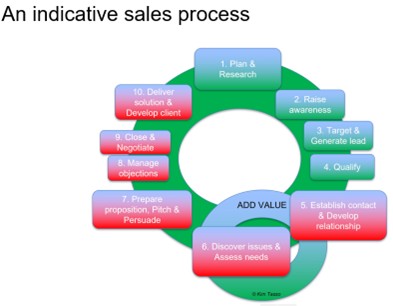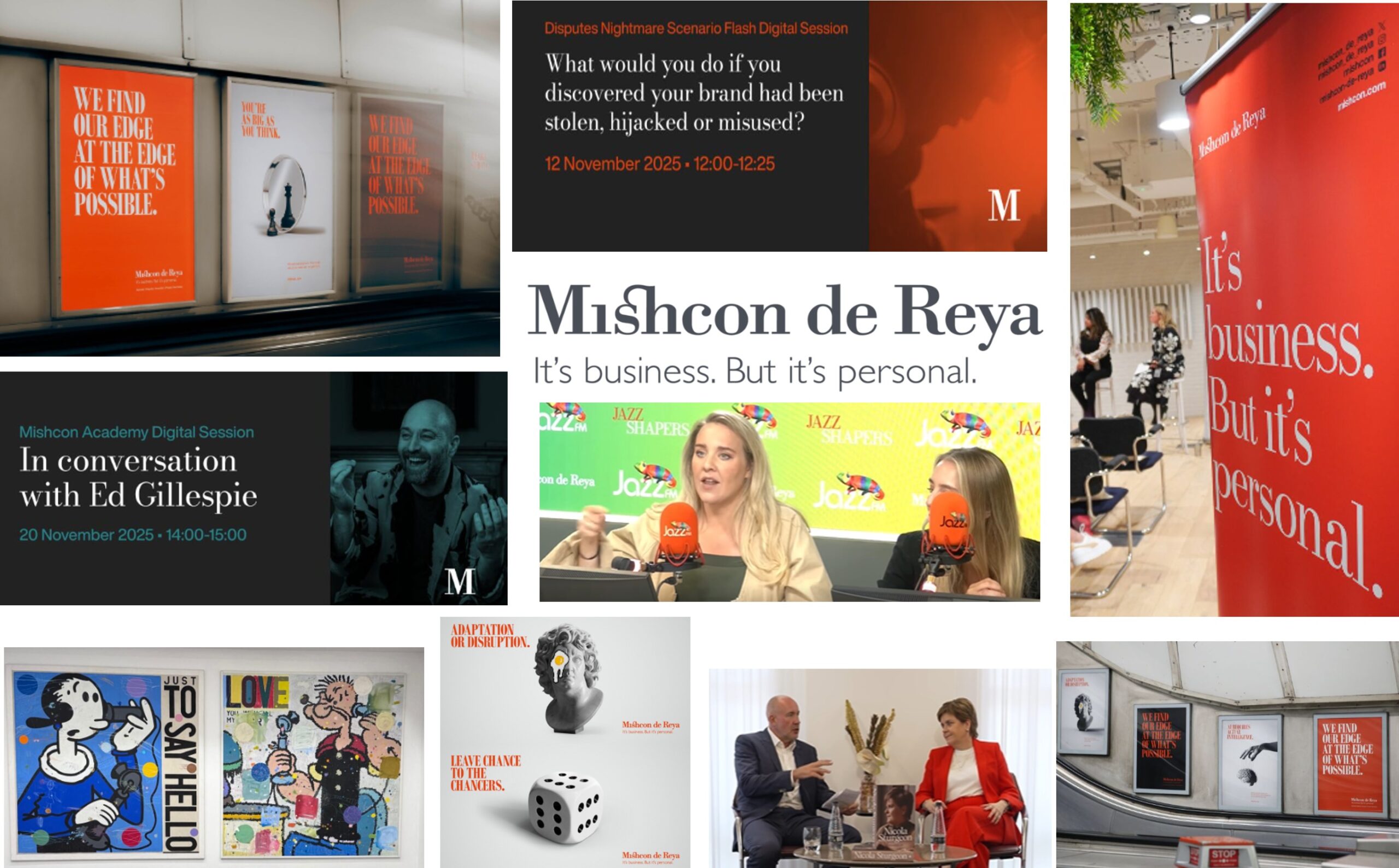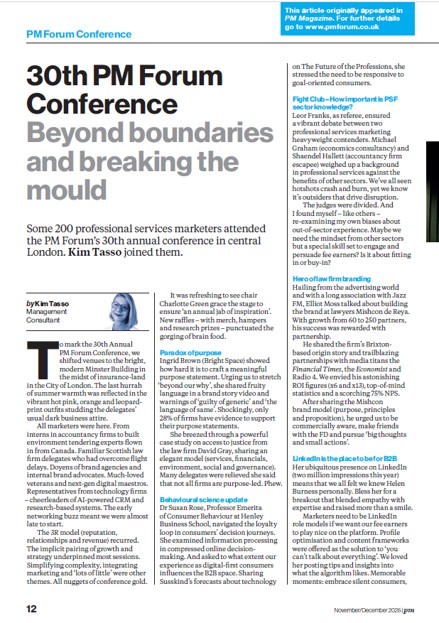
It was a full house for July’s “Be more strategic” PM Forum – PM Forum workshop for marketing and business development (MBD) professionals. During the session we considered three key areas: thinking strategically, business strategy and marketing/business development strategy. Be more strategic – Strategy is about making choices.
Strategy is about making choices
We considered many case studies and examples of some of the most successful professional services firms’ strategies. And observed that making (hard) choices underpinned success. Comments included:
- Less is more
- Do less but do it better
- Go big, go niche or go home
Making choices is at the heart of most strategic management frameworks. For example, the model of strategic management by Johnson & Scholes covers:
- Strategic analysis
- Strategic choice
- Strategic implementation
And choices are central in Ladley and Martin’s “Playing to Win”:
- What is our winning aspiration?
- Where will we play?
- How will we win?
- What capabilities must we have?
- What management systems do we need?
They further break this process down into:
- Industry analysis
- Client value analysis
- Analysis of relative position
- Competitor analysis
- Strategic choice
By focusing resources on the chosen strategies:
- The whole firm is aligned to amplify the chosen strategies
- There is less noise and more clarity internally and externally
- Marketing and business development (MBD) shifts from reactive service provider to proactive value generator
- There is less risk of diluting effort by trying to do everything and spreading ourselves too thinly
This also means that low priority activities must be downgraded, postponed or stopped altogether. And such choices are particularly hard for complex professional services firms where there are usually many markets and many services. Although MBD can mitigate the difficulties by providing the tools and processes so that fee-earners can do more of the tactical activities themselves – perhaps using administrative resources.
Engage stakeholders in making strategic choices
Strategic choice is particularly difficult when the dominant culture is with “doing stuff” (tactical) rather than systematically considering the aims, the best approach and measuring the impacts (strategic).
So this elevates the importance of stakeholder engagement in strategy development and implementation in professional services firms. We must enlist stakeholders in supporting the strategic choices that are made by the firm for the firm.
It is notoriously hard to unify everyone in the firm around the chosen aims and strategies. But we can include and engage people in strategic analysis and choice phases to earn their trust, buy-in and motivation. Internal engagement therefore becomes critical to:
- engage people
- share the analysis, data and options
- seek input, feedback and refinement
- consider the systemic impacts of the chosen strategy
- commit to focus on the chosen strategies
This approach is also helpful to guide people to consider the external view: what’s going on in the world, how market trends will impact clients, monitoring competitor action, what client feedback is telling us etc. So it can lead to cultural change. To become more client focussed. And help people snap out of their silo, internal and short term views.
Firms use all manner of techniques to promote engagement: awaydays, town halls, staff surveys, team meetings, workshops, training and internal communications. They articulate the chosen strategy. And look at how that strategy impacts different activities. As well as showing how it helps the firm and everyone in it for the long run.
Stakeholder engagement and buy-in articles
As stakeholder engagement and fee-earner buy in is so important to strategy and other marketing and business development topics, we run separate trainings on the topic. Here are some resources that may help:
Buy in – Influence and Persuasion Toolbox – Kim Tasso March 2025
Consulting Skills – The power of workshops – Kim Tasso February 2025
Change challenges – Culture, Communications and Clutter December 2024
Achieve more engagement and buy-in March 2024
Influence and persuasion skills with Aristotle and Knights and Dinosaurs May 2023
Ten top takeaways on stakeholder engagement and buy in April 2022
Seven thoughts on stakeholder management, engagement and buy-In April 2021
Animal magic of buy-in and stakeholder engagement (Video) September 2020
all about buy-in in professional services (Manchester and Dublin 2019) March 2019
Examples of strategic choices for professional services firms
We considered many strategic frameworks and models – but particularly SOSTAC for strategic marketing:
- Situation analysis
- Objectives
- Strategy
- Tactics
- Action
- Control
A comprehensive marketing audit (or situational analysis) should reveal ideas, opportunities and threats. Data driven strategic analyses will identify all the strategic options available. Clear objectives will then enable teams to select those strategic choices that will achieve goals with the greatest efficiency and effectiveness.
We talked about some of the many strategic choices faced by a professional services firm at both the firm-wide level and for marketing and business development. These choices go beyond the traditional view of marketing strategy – “Which services to promote in which markets at which price and with what promotion”.
- Choose goals
- Short term vs. long term goals
- Revenue (volume, market share) vs. profit (value, margin) goals
- Reputation, perception and positioning goals
- Client service satisfaction, loyalty and retention goals
- External market goals vs Internal efficiency goals
- Number of employees
- Balance of revenue for new or existing clients
- Top down (from the centre) or bottom up (from the divisions or teams) goals
- Level of focus goals – what you need the firm, divisions or individuals to achieve
- Choose context/frame of reference
- External – Macro and geopolitical analysis (PESTLE)
- External – Micro and competitive analysis
- External – Market future trends, opportunities and threats
- External – Client focus and needs
- Internal – Strengths, resources and competencies
- Internal – Data-driven past performance
- Monitor and adapt to weak signals
- Choose investment
- High or low risk and return expectations
- Board and Management attention and time
- Mergers and Acquisitions (M&A)
- Diversification
- Strategic lateral hires
- Use of cash and fee-earner time
- Inhouse or outsourced expertise
- Infrastructure and data sources
- Choose markets
- Existing market penetration vs. new market development (Ansoff)
- Domestic vs. overseas markets (international strategy)
- Global standardisation vs Local adaptation (international strategy)
- Penetration or development of markets
- Segmentation and identification of new segments or niches
- Choose services
- Established services vs. new services (Ansoff)
- Advisory services vs. commodity services
- Innovation source of new services
- AI automation (e.g. LawTech or FinTech) or people-driven services
- New product and new service development
- Diversification into related professional or commercial services
- Choose business and marketing strategies
- Alignment – Vertical, horizontal and internal (the “one firm” approach)
- Culture and decision-making – Centralised vs. decentralised
- Balance of planned vs. emergent strategy
- Innovation and/or continuous improvement strategies
- Internal culture development and Employer Value Proposition (EVP)
- Differentiation (e.g. brand strategy) vs. Low-cost leadership (Porter’s Generic Strategies)
- Firm brand vs Team brands (multi-niche) vs Personal brands
- Market leader vs Market follower approach
- Broad market vs Niche Market (Porter’s Generic Strategies)
- Grow existing (legacy) clients vs. New client acquisition
- Relationship strategy vs. Transaction based strategy
- Channels to market (Go to market strategies)
- Client journey mapping, client experience management and service improvement strategies
- Research strategies
- Thought leadership and issues-based marketing
- Note: We mentioned AI-powered thought leadership research System review: CogniClick for instant, personalised research October 2023
- Key Account Management (KAM) and Account Based Marketing (ABM)
- Referrer and intermediary management
- Cross-selling initiatives
- Collaboration with strategic partners
- Sustainability and environmental focus
- Lateral hires for new service development
- Use of automation and technology
- Partner-led vs whole firm involvement
- Dedicated and specialist rainmakers vs. Whole firm involvement
- Choose tactics
- Internal engagement
- Personal brands and amplification
- 7 Ps (Place, Product, Price, Promotion, People, Processes, Physical evidence etc) tactics
- Promotional mix blend:
- Public Relations (includes media relations, investor relations, community engagement, internal marketing etc)
- Advertising (and sponsorship)
- Digital marketing
- Personal selling
- Sales promotion (short term sales promotions)
- Integrated marketing, business development and selling campaigns
- Digital marketing strategy
- Traditional vs. Online networking
- Omnichannel vs specific channel (e.g. LinkedIn First)
- Content marketing
- Local community engagement
- Efficiency and effectiveness measures
About the delegates
Delegates ranged from Marketing/Business Development managers and executives to those focused on bids, contracts, events, campaigns and international relationships.
They were representatives of large and medium sized legal and accounting firms and also the property sector. We also welcomed those focused on particular sectors (energy, retail, leisure) and services (employment, pensions) and from forensics accountancy and economics consultancies.
Delegate aims
- Need to be more strategic
- Firm has grown and we need to be more strategic then reactive
- Recently taken on a sector focused role and want to make sure I’m as strategic as possible
- Looking to always present strategically rather than reactively
- Refresher on strategic thinking to make sure I’m making the most out of our activity
- As a firm we are seeing really positive growth and so we are looking at how we can be more strategic going forward
- Become more strategic in my approach rather than the more tactical approach I currently take
- Priority is now focusing on firmwide campaigns and focusing on the bigger picture
- Working on developing strategic growth plans with the teams that I work with and looking to be more strategic than reactive
- Career progression
- Hoping to make the next step in my career and progress generally by learning new skills
- Improve my strategic thinking as I progress in my career
- I’d like to learn to be more strategic when finding solutions to various problems
- Communicating strategy for stakeholder buy-in
- Effectively challenging the strategic status quo
- Knowledge and skills development
- Expand on my knowledge of the frameworks explored whilst studying with the CIM – obtain more “real life” examples aimed at professional services
- Insights into business planning that I can apply to the international teams
- Boost my understanding of, and role in, strategy in my practice and the firm, so I can add more value and make a visible difference
- Gain more knowledge on how I can bring strategic thinking and a more strategic approach to my day-to-day role
- Heavily involved with AI implementation within the marketing dept, so hoping today’s session can influence my work in this area as well to blend strategy and innovation
- Wider understanding setting up strategic campaigns, frameworks and focussing on the big picture
Delegate takeaways
- Strategic analysis
- Try a marketing audit to see what our strengths and weaknesses are so that we can align our activities with the overall business objectives going forward
- PESTLE analysis
- Reviewing competitors
- More focus on competitor analysis
- Review in detail what my sector’s main competitors are doing and what can we learn from this
- The need for quality data to assess effectiveness
- Strategic choices
- Difference between business/company strategy and marketing/BD strategy and how they interact
- Focus on less but GO BIG on those elements.
- If you want to do more things, what are we not going to do anymore, stop doing, as we can’t do everything
- Be bold in prioritising and choosing a few markets/sectors to focus on rather than trying to target everything.
- Efficiency and effectiveness vs the goal – for a smaller marketing team what are capable of achieving strategy wise within the limitations of team capacity
- Stakeholder engagement and alignment
- Find out more about our business strategy to align our campaigns with the business
- Joining the dots between the firm strategy and individual team strategies
- Strategically reflect on the goals and objectives of the firm, team and projects. Consider how this is aligned with the firmwide strategy
- Empowering and informing myself to feel confident to speak to fee earners about strategy and position myself (and the team) as strategic and not just support
Delegate poll results
Delegates find it useful to review the poll results to benchmark their views and firms against comparable firms.
Which sector do you represent?
- 75% Legal
- 13% Consulting
- 6% Property/engineering
- 6% Other (Financial – Pensions)
- 0% Accountancy, insolvency, actuaries
How would you rate your experience in strategy?
- 0% None
- 25% A little
- 69% Average
- 6% A lot
Which topic is of most interest to you?
- 44% Thinking strategically
- 25% Understanding business strategy/strategic analysis
- 25% Marketing and Business Development strategy
- 6% Other
Where is your main strategic focus?
- 0% Firm overall
- 25% Sectors
- 44% Departments/Practice Groups
- 0% Territory
- 0% Individual fee-earners
- 25% Campaigns or projects
- 6% Something else
Which area presents the biggest challenge?
- 12% Strategic analysis
- 6% Generate strategic options
- 12% Strategy choice
- 65% Strategy implementation
- 6% Something else
Have you completed a marketing audit for your firm/team?
- 25% Yes
- 75% No
Which element of strategic analysis do you think you most need to improve at your firm?
- 6% External analysis – far environment (PESTLE)
- 25% External analysis – sector issues and trends
- 31% External analysis – competitors
- 31% External analysis – clients
- 0% Internal analysis – strengths and weaknesses
- 6% Internal analysis – past clients and sources of work
Which frameworks have you or do you use?
- 88% Segmentation Targeting and Positioning (STP)
- 24% SOSTAC
- 18% STAR digital marketing
- 12% BCG portfolio analysis
- 12% Positioning/perceptual maps
- 6% Porters Generic Strategies/Five Forces
- 6% McDonald’s marketing planning
- 0% Ansoff markets and services
- 0% RACE digital marketing
Which of the following is closest to describing your goals?
- 6% Really well designed – objectives and KPIs for financial and other measures
- 63% Well defined – revenue, reputation and relationships
- 25% Partially defined – there are some goals and objectives
- 0% Poor – there are activity-based goals but not results-focused
- 6% Poorly defined – it’s unclear what we are trying to achieve
Which segmentation approaches are used in your firm?
- 94% Market or industry sector
- 69% Geography/region
- 50% Job function
- 50% Nature of relationship
- 38% Size of business
- 19% Personas
How do you rate your firm’s measurement of MBD effectiveness?
- 7% Excellent
- 20% Good
- 53% Average
- 20% Poor
Related strategy and strategic posts
Key Account Management (KAM) – Start small, Be strategic June 2025
Highlights from the 2025 Professional Growth Summit – Kim Tasso May 2025
Book Review: Strategic Tendering for Professional Services April 2025
Transition from technical expert to adviser March 2025
Political, Practice and Marketing Trends February 2025
Consulting Skills – The power of workshops – Kim Tasso February 2025
Marketing case studies – Digital thought leadership campaigns February 2025
Be more strategic – Strategy into Action (Strategy Implementation) December 2024
Change challenges – Culture, Communications and Clutter December 2024
Referrer management: Diagnosis, Aims, Strategies and Action November 2024
Planning Digital Marketing Campaigns and Content Strategy November 2024
Business Development Coaching Insights – Kim Tasso September 2024
create a digital marketing strategy in a professional services firm September 2024
Be more strategic – Stretch your strategy muscle May 2024
Be more strategic: Top-down or bottom-up, marketing (kimtasso.com) December 2023
Book review: The Strategy Book by Max McKeown (kimtasso.com) November 2023
Being more strategic – Case studies and insights (Ireland May 2023) (kimtasso.com) June 2023
Managing Partners’ Forum Strategy Summit (kimtasso.com) June 2023
Be more strategic – A metaphor: Analyse, join and align the dots (kimtasso.com) March 2023
Strategy case studies and more matrices (kimtasso.com) February 2023
Annual International Marketing Benchmark – PM Forum and Meridian West (kimtasso.com) January 2023
Be more strategic – PESTLE, Positioning and Plans (kimtasso.com) December 2022
Future Marketing/BD Manager – Build your personal brand (kimtasso.com) December 2022
Key issues in Marketing and Business Development Planning (kimtasso.com) July 2022
Be more strategic – Eight insights (February 2022) (kimtasso.com) March 2022
Take them on the strategy journey (kimtasso.com) September 2021
Strategic thinking it’s a jungle out there (kimtasso.com) February 2021
Be more strategic – Strategy in a post-Covid19 world (kimtasso.com) July 2020
Improve your strategic thinking – Seven insights (2020) (kimtasso.com) June 2020
Be more onion, time out from the tsunami and other strategy insights (kimtasso.com) March 2019
Strategic thinking – Audits, assumptions and alignment (kimtasso.com) March 2018
Marketing planning in a nutshell – simple and complex plans (kimtasso.com) June 2017
Strategy development insights – curiosity culture and change (kimtasso.com) March 2017








